Choosing the Right Disposable Gloves
It is not surprising in the COVID-19 era that the disposable gloves market is set to grow by 14% in the next seven years. The global market of nitrile gloves in particular will be worth $8.98 billion according to experts.
Disposable gloves are now one of the most commonly used safety products in the world. They have always been associated with doctors, nurses and the medical sector as staff strive to prevent cross-contamination between patients and staff. But, now disposable gloves are commonplace as the general public strives to protect themselves from coronavirus.
There are several different types of disposable glove and they all have different roles.
Latex Gloves
Latex is thought to be the most versatile glove, but it does contain a protein that can cause an allergic reaction in some people. And, because they are made of a natural material, they are biodegradable.
Polyethylene Gloves
Poly gloves are commonly worn in the food preparation sector as they are easy to get on and off quickly when chefs and prep staff are moving between different tasks.
Neoprene Gloves
Neoprene is thick and heat resistant, and these types of gloves are reusable. They are commonly used for dishwashing and tasks that involve water. These are also really good protection against chemicals, acids and other dangerous substances.
These are also commonly used in the foodservice industry. They are comfortable to wear, safe and latex-free, which is important in food preparation as latex can cause reactions in some people.
Nitrile Gloves
It is said that these are the most versatile gloves available. They are the most commonly used in the medical sector. They come in various thicknesses – from 3mm for the food preparation industry and up to 6mm for the industrial sector. They can be bought allergen, latex and powder-free so different businesses can buy the type that most suits their needs.
Powdered gloves or non-powdered gloves?
Powdered gloves are easier to put on and take off. They prevent friction between the skin and the glove material, which also makes it less likely to rip or tear during use. The powder in gloves is normally made from cornstarch, but even so, they are still not usually used in the food industry in case of cross-contamination with the food that is being prepared. The main benefit of non-powdered gloves is that they don’t leave the remnants on the powder on hands after use.
Latex v Nitrile
Latex gloves are strong and durable. They are very elastic, which makes it easy for people to put gloves on and take them off. It is a natural material – made of rubber, which is biodegradable. They are soft and flexible, which makes them comfortable to wear, and they are safe to wear for long periods of time.
Many people who wear latex gloves say that they feel like a second skin. Surgical gloves are often made of latex as it helps surgeons retain good movement and dexterity during their procedures.
The main drawback of latex gloves is the fact that they can cause allergic reactions. It is said that six percent of people are sensitive to latex. Reactions can vary from minor rashes to anaphylactic shock.
Nitrile is a synthetic version of latex. It is chemical and puncture-resistant and it is fast becoming the most popular type of glove used by hospitals, emergency staff, police officers, security guards, housekeepers, factory workers and vets. Nitrile is formed by combining acrylonitrile and butadiene to create a synthetic copolymer.
Nitrile gloves are the hypoallergenic choice. They are easy to put on and they are often used in emergency rooms where doctors might not know what allergies a patient has. But nitrile gloves, while they are very strong, they are not as comfortable as latex and they are not recommended for work that needs precision, fine movements and dexterity. They are more likely to be used in examinations and by doctors and surgeons carrying out minor procedures.
What are the protection levels of gloves?
Nitrile gloves will protect against most chemicals and corrosive materials, but it is not recommended that they are used in high-risk situations. They are waterproof, greaseproof and oil proof. Rubber gloves are good to use if you are handling mildly corrosive products. Neoprene gloves are recommended for use with most solvents, oils and corrosive materials.
Where to buy disposable gloves?
In these days of the coronavirus, disposable gloves are now a common find on the shelves of supermarkets, pharmacies and home improvement stores. Many online stores are now stocking them, and there are even special disposable glove stores on eBay.
Wearing of disposable gloves has been commonplace in many sectors for many years, but in these new times we live in almost every worker in every sector is wearing gloves for the protection of themselves and others.




Very important points regarding safety procedures. While dealing in chemicals, acids, etc. it is very important to wear goggles, gloves and other protective as it can be life saving. Safety signs can be used to inform the workers about the safety measures. Wonderful blog with good points. Thanks a lot.
ReplyDeleteVery interested and creative post. Thanks for sharing...
ReplyDeleteProtective Gloves Wholesale
Nitrile Gloves Diamond Texture supplier
ReplyDelete